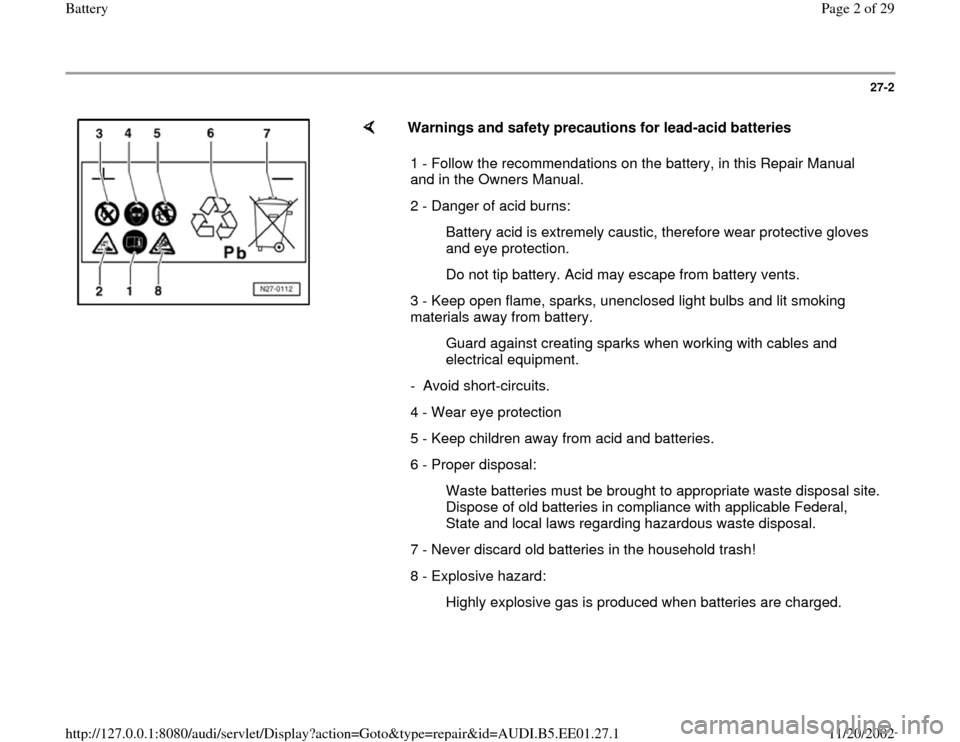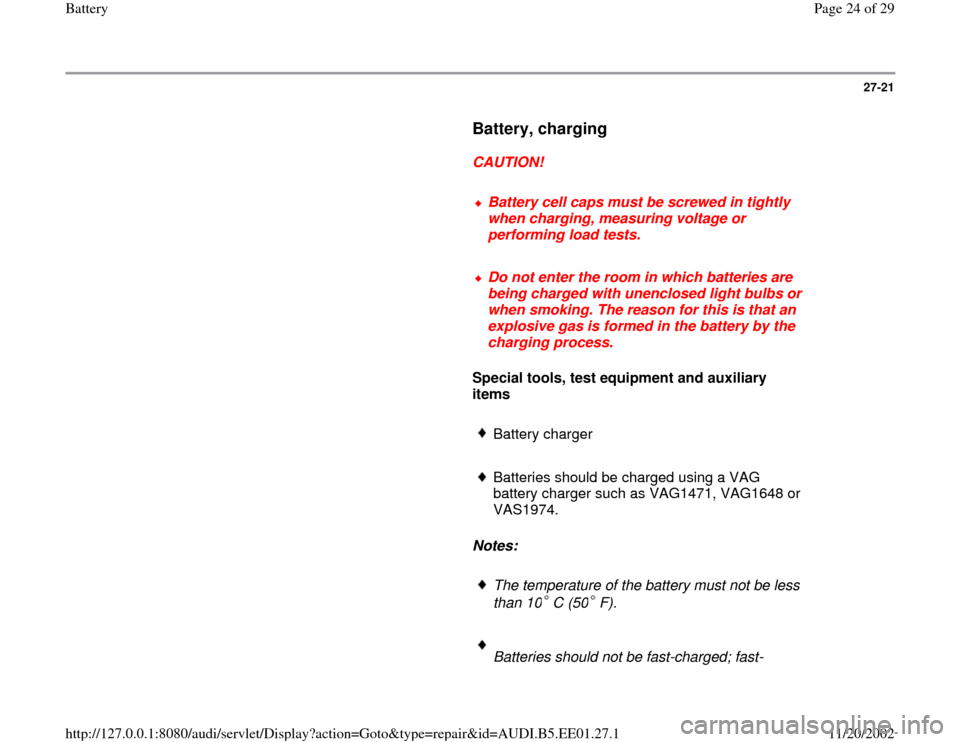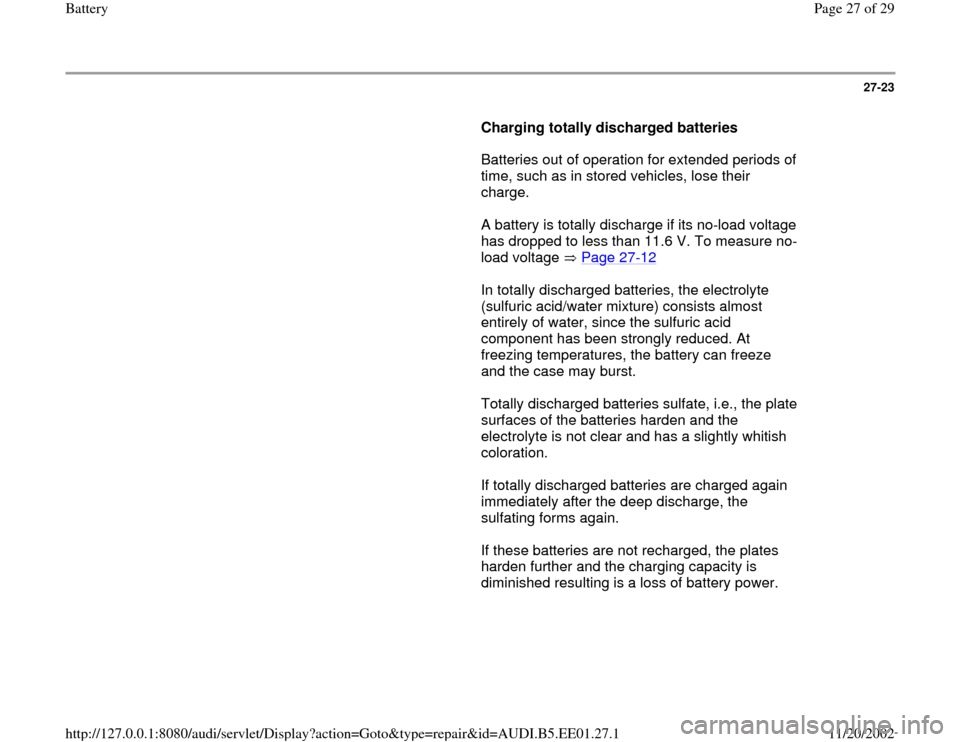light AUDI A4 1998 B5 / 1.G Battery Workshop Manual
[x] Cancel search | Manufacturer: AUDI, Model Year: 1998, Model line: A4, Model: AUDI A4 1998 B5 / 1.GPages: 29, PDF Size: 0.19 MB
Page 2 of 29

27-2
Warnings and safety precautions for lead-acid batteries
1 - Follow the recommendations on the battery, in this Repair Manual
and in the Owners Manual.
2 - Danger of acid burns:
Battery acid is extremely caustic, therefore wear protective gloves
and eye protection.
Do not tip battery. Acid may escape from battery vents.
3 - Keep open flame, sparks, unenclosed light bulbs and lit smoking
materials away from battery.
Guard against creating sparks when working with cables and
electrical equipment.
- Avoid short-circuits.
4 - Wear eye protection
5 - Keep children away from acid and batteries.
6 - Proper disposal:
Waste batteries must be brought to appropriate waste disposal site.
Dispose of old batteries in compliance with applicable Federal,
State and local laws regarding hazardous waste disposal.
7 - Never discard old batteries in the household trash!
8 - Explosive hazard:
Highly explosive gas is produced when batteries are charged.
Pa
ge 2 of 29 Batter
y
11/20/2002 htt
p://127.0.0.1:8080/audi/servlet/Dis
play?action=Goto&t
yp
e=re
pair&id=AUDI.B5.EE01.27.1
Page 24 of 29

27-21
Battery, charging
CAUTION!
Battery cell caps must be screwed in tightly
when charging, measuring voltage or
performing load tests.
Do not enter the room in which batteries are
being charged with unenclosed light bulbs or
when smoking. The reason for this is that an
explosive gas is formed in the battery by the
charging process.
Special tools, test equipment and auxiliary
items
Battery charger
Batteries should be charged using a VAG
battery charger such as VAG1471, VAG1648 or
VAS1974.
Notes:
The temperature of the battery must not be less
than 10 C (50 F).
Batteries should not be fast-charged; fast-
Pa
ge 24 of 29 Batter
y
11/20/2002 htt
p://127.0.0.1:8080/audi/servlet/Dis
play?action=Goto&t
yp
e=re
pair&id=AUDI.B5.EE01.27.1
Page 27 of 29

27-23
Charging totally discharged batteries
Batteries out of operation for extended periods of
time, such as in stored vehicles, lose their
charge.
A battery is totally discharge if its no-load voltage
has dropped to less than 11.6 V. To measure no-
load voltage Page 27
-12
In totally discharged batteries, the electrolyte
(sulfuric acid/water mixture) consists almost
entirely of water, since the sulfuric acid
component has been strongly reduced. At
freezing temperatures, the battery can freeze
and the case may burst.
Totally discharged batteries sulfate, i.e., the plate
surfaces of the batteries harden and the
electrolyte is not clear and has a slightly whitish
coloration.
If totally discharged batteries are charged again
immediately after the deep discharge, the
sulfating forms again.
If these batteries are not recharged, the plates
harden further and the charging capacity is
diminished resulting is a loss of battery power.
Pa
ge 27 of 29 Batter
y
11/20/2002 htt
p://127.0.0.1:8080/audi/servlet/Dis
play?action=Goto&t
yp
e=re
pair&id=AUDI.B5.EE01.27.1